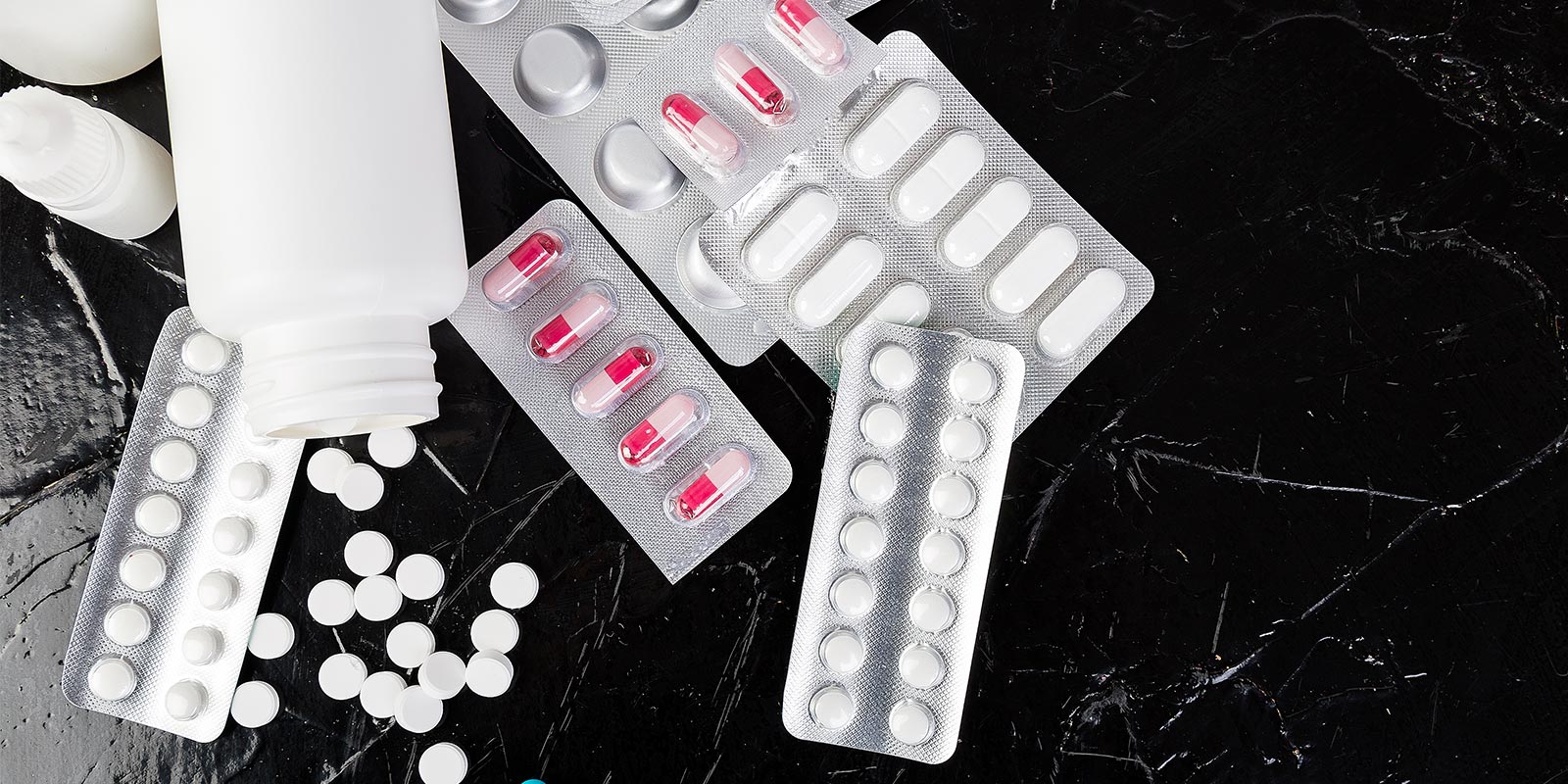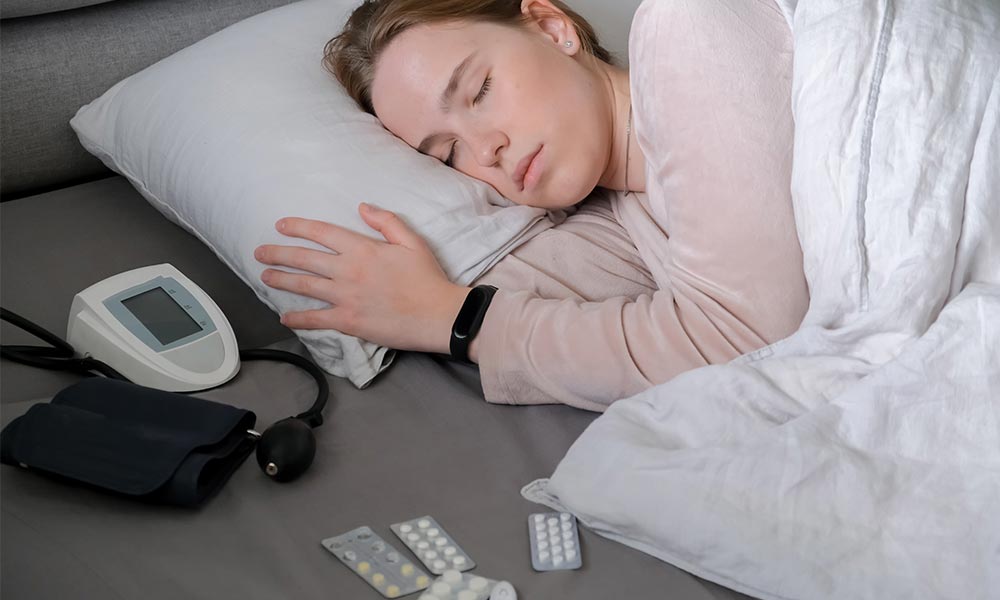Side Effects of Trazodone for Sleep – What To Expect

- Mild issues like dry mouth or vivid dreams are common, but seek immediate help for fainting, irregular heartbeat, or signs of serotonin syndrome.
- Take trazodone 30–60 minutes before bed, allow 7–8 hours of sleep, and skip alcohol to reduce next-day grogginess.
- Long-term nightly use may cause tolerance and rebound insomnia, making a slow taper and solid sleep-hygiene habits critical.
Trazodone is an antidepressant, but with a significant sedative effect at low doses, it soon became a common off-label treatment for insomnia. Unlike most common sleep medicines, it acts on serotonin receptors and blocks histamine.
As a result, many people who take it not only fall asleep faster but also stay asleep longer. Doctors may prescribe it for patients due to concerns about habit-forming drugs often used for sleep.
Taking trazodone isn’t risk-free, and there are both short-term and long-term side effects of trazodone for sleep. By monitoring how you feel each morning and collaborating with your prescriber, any new symptoms that pop up can be addressed immediately.
Common Side Effects of Trazodone for Sleep or Insomnia
Drowsiness & Morning Grogginess
Sleepiness is exactly why doctors prescribe trazodone at night, but the sedative effect often lingers into the next day.[1] Clinical trials report daytime drowsiness in roughly one-third of users. If you feel foggy at breakfast or struggle to focus at work, start the dose earlier in the evening, aim for a full seven-to-eight-hour sleep window, and skip alcohol or other sedatives that can amplify hangover-like fatigue.
A lot of patients find that reducing the dose by a small amount can help reduce grogginess while still getting enough to help them sleep. Keeping the lights bright in the morning and going on a brief walk can also signal your body that it’s time to wake up.
Dry Mouth and Gastrointestinal Issues
Since trazodone blocks several of the receptors tied to saliva and gut motility, dry mouth, nausea, constipation, and even heartburn can start in less than two weeks.[2] Making sure you stay hydrated, chewing sugar-free gum, and eating plenty of high-fiber foods like oatmeal and berries can help relieve some of the symptoms.
If constipation continues, you might want to consider asking your provider about over-the-counter stool softeners. Long-lasting stomach pain or severe pain should always be cause for concern. Symptoms like these could indicate the need to switch sleep aids. Consult your primary care provider if you experience troublesome side effects.
Orthostatic Hypotension & Lightheadedness
Taking trazodone relaxes the blood vessels and lowers blood pressure when standing.[3] For some people, this can mean a short dizzy spell, and potentially even fainting when sitting or standing up quickly.. This can be much more pronounced or occur more frequently in older individuals as well as those who take antihypertensives. To help your body adjust to posture changes, dangle your legs for a minute after you sit up in bed, before you stand up fully.
If you notice symptoms with postural changes happening more frequently, or if their severity increases, speak with your clinician. They may recommend splitting the dose or switching medications. The same applies to falls or near-falls. Make sure you report them to your provider so dosages can be monitored or adjusted.
Trazodone Vivid Dreams and Nightmares
As it alters the REM sleep cycles, trazodone can also make dreams feel much more intense and memorable after waking. While some individuals find they enjoy the cinematic sleep experience, others experience disturbing images and nightmares. Tracking dream patterns in a journal helps you and your provider decide whether to continue, change the dose, or try an alternative sleep aid. Reducing caffeine in the afternoon and practicing relaxation breathing or meditation before bed can lessen dream intensity.
Headaches and Blurred Vision
Mild headaches or brief visual blurring sometimes appear during the first few weeks of use as the body adapts. Staying hydrated, eating balanced meals, and taking breaks from digital screens can help. If headaches become severe, vision changes last more than a few minutes, or you notice eye pain, contact your healthcare provider right away. They’ll need to rule out rare but serious complications like angle-closure glaucoma.
Serious & Rare Side Effects
Priapism
Trazodone is known to cause prolonged, often painful erections that can last for more than four hours.[4] This is a medical emergency known as priapism. It’s rare, but it can occur within the first few hours of treatment, or sometimes after dosages are increased.
In an emergency, it’s important to get emergency medical care as soon as the symptoms occur. Delays in treatment can lead to permanent tissue damage, so get to the ER as soon as possible if you have an erection that will not subside.
Serotonin Syndrome
Another rare but serious condition, serotonin syndrome, can occur when trazodone is combined with other substances that increase serotonin.[5] This includes SSRIs, MAOIs, triptans, and even the supplement St. John’s wort. Early signs of serotonin syndrome include sweating, restlessness, rapid heartbeat, goosebumps, and shivering. More serious cases include high fever, muscular rigidity, and possible seizures.
Call 911 if symptoms continue to escalate. Serotonin syndrome is a medical emergency, and if untreated, it has the potential to be fatal.
Heart Rhythm Disturbances
Trazodone may trigger abnormal heartbeats, especially in people with existing cardiac disorders or taking other drugs that affect the heart. High-risk patients should have an EKG before and after dosage changes.
Hyponatremia
In rare cases, trazodone lowers sodium levels, causing headaches, confusion, nausea, or muscle cramps. Older adults and those on diuretics face a higher risk. See your doctor if you have these side effects.
Suicidal Thoughts in Young Adults
Like many antidepressants, trazodone carries an FDA boxed warning for increased suicidal ideation in people under 25. Families should monitor mood shifts, agitation, or talk of self-harm, especially during the first few months of drug use or when doses change. Report these to your physician.
Long-Term Effects & Withdrawals
Cognitive Impact
It’s not uncommon for people to take trazodone for months or even years when insomnia is chronic. Over time, some people begin to notice that the original 50mg or 100mg dose isn’t giving them the same effect. This is tolerance in action. Rather than chasing sleep with higher dosages and risking more serious side effects, talk to your provider.
A few studies also note mild memory or concentration problems after long-term use, especially in older adults.[6] Staying mentally active with reading, puzzles, or hobbies can offset fog, and periodic medication reviews help keep doses as low as possible. Report these symptoms to your doctor.
Emotional Impact
Because there’s such a profound impact on serotonin levels, long-term use can lead to subtle mood changes. In some individuals, this lingering antidepressant activity improves general outlook, but for others, it can flatten emotions or even spark agitation, particularly in people with bipolar disorder. Younger adults also need additional monitoring for suicidal ideation after dose increases.[7] Journaling can help track the shifts, good and bad so that they can be accurately shared with your provider.
Dependence Risk & Withdrawal Symptoms
Trazodone isn’t considered habit-forming like benzodiazepines, yet your body can still adapt to nightly dosing. If you stop abruptly, you might feel rebound insomnia, irritability, vivid dreams, or flu-like aches within a couple of days. Sometimes, this comes with nausea and lightheadedness as well. Gradually tapering the dosage down each week or two lets your brain chemistry reset and reacclimate at a more comfortable pace. During the taper, make sure sleep is anchored with consistent bedtimes, in a cool, dark room, and incorporates calming routines like reading or gentle stretching and relaxing breathing before sleep. Tapering should be supervised by a physician.
Find a Healthy Balance
Trazodone can be a helpful bridge between sleepless nights and healthy rest, yet no pill is perfect. Knowing the common side effects, recognising the rare but serious ones, and sticking to safe habits can keep the benefits outweighing the risks. If you find that problems are cropping up, don’t deal with them solo; reach out to your primary care provider for help.
Frequently Asked Questions About Side Effects of Trazodone for Sleep

